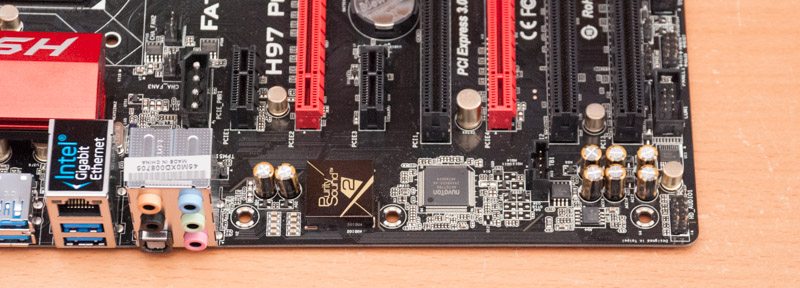ASRock Fatal1ty H97 (LGA 1150) Motherboard Review
Ryan Martin / 11 years ago
A Closer Look & Layout Analysis
The eagle eyed viewer will notice that the ASRock Fatal1ty H97 Performance motherboard is a little on the “slim” side. ASRock have opted for a reduced width ATX design to save on the production costs. This means there is less space on the motherboard but less space is needed as less features are present than on a Z97 ATX motherboard for example. The layout of the motherboard has suffered a bit from the size, for example we have vertical facing SATA ports which is a nightmare for cable management and we also have a random molex in the centre of the motherboard. The “separated PCB” for the audio has also suffered, in fact it is not separated at all – the last picture on this page shows that there are just random strips of unconnected “PCB separater” which in effect renders it useless because it is not separated. I think ASRock could have designed this motherboard better than it is. If I could have my way I would reduce the size of the PCH heatsink to allow for horizontal mounted stacked SATA ports, I would move the USB 3.0 header to where the SATA ports are now and I would relocate some components towards the centre of the motherboard to allow the audio area adequate room for full PCB separation. I’d also ditch the molex supplementary because it is totally unnecessary for this type of motherboard.

The CPU VRM still gets the high quality power components ASRock use on more expensive motherboards and there are still an impressive 8 phases. We only get one CPU VRM heatsink though as this seems to be part of the cost saving exercise.

ASRock provide a generous 3 fan headers near the CPU socket which is nice if you happen to have a dual fan AIO liquid cooler.

The SATA area features upward mounted SATA ports and a seemingly oversized PCH heatsink for what is a fairly narrow motherboard.

Along the bottom we find six SATA III ports, a chassis fan header, two USB 2.0 headers, front panel connectors, a COM port, the HD audio connector, a thunderbolt connector and a TPM header.

The audio implementation sits at the back of the motherboard but the PCB separation is non-existent despite vague attempts to make it look separated. We can see the use of EMI shielding on the codec and high quality Nichicon audio capacitors which is nice for a budget motherboard.

The PCI layout is fairly primitive, I doubt we’ll see anyone needing three PCI ports. I would prefer it if ASRock had swapped the last PCI lane out with another PCI express lane of some sort.

The rear I/O contains the following ports:
- 1 x PS/2 Mouse/Keyboard Port
- 1 x D-Sub Port
- 1 x DVI-D Port
- 1 x HDMI Port
- 1 x Optical SPDIF Out Port
- 3 x USB 2.0 Ports
- 1 x Fatal1ty Mouse Port (USB 2.0)
- 4 x USB 3.0 Ports
- 1 x RJ-45 LAN Port with LED (ACT/LINK LED and SPEED LED)
- 5 x HD Audio Jacks

As I mentioned earlier from this picture you can see the fairly unfinished attempt at audio PCB separation. However, a full black PCB for a budget motherboard like this is something to be pleased with.




















